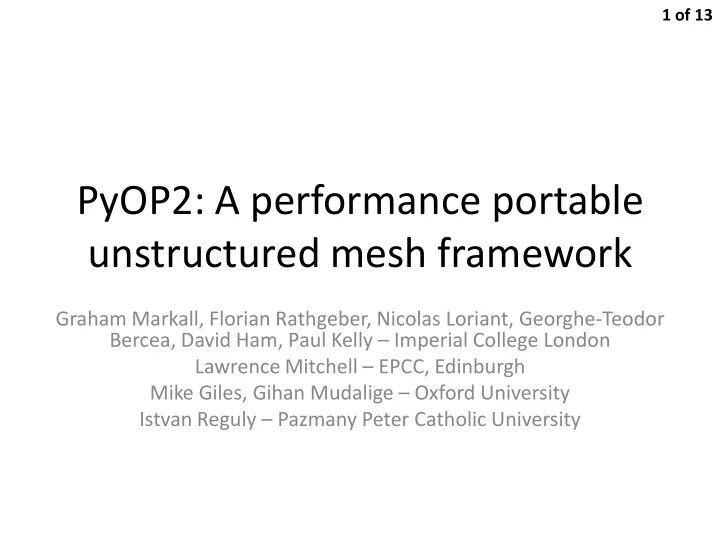

1 of 13 PyOP2: A performance portable unstructured mesh framework Graham Markall, Florian Rathgeber, Nicolas Loriant, Georghe-Teodor Bercea, David Ham, Paul Kelly – Imperial College London Lawrence Mitchell – EPCC, Edinburgh Mike Giles, Gihan Mudalige – Oxford University Istvan Reguly – Pazmany Peter Catholic University
2 of 13 • Performance portability: platform-agnostic performance without source code changes • It is essential for performance portability that both a kernel and its call site are generated – GPU: Kernel call, shared memory staging – CPU: AVX vectorisation, data movement
3 of 13 PyOP2 • Driving application: finite element assembly • Hardware-specific performance optimisations in the form compiler breaks modularity • Based on OP2 – static-compiled C++ API • Python re-implementation – JIT Compilation – Linear algebra – Iteration spaces
4 of 13 PyOP2 Overview Application code API boundary Linear Algebra Runtime Core (PETSc, CUSP) Backends Sequential C C with OpenMP OpenCL CUDA MPI Code gen Instant PyOpenCL PyCUDA
5 of 13 3 2 Data declarations 1 0 dofs = op2.Set(4) cells = op2.Set(2) 0 1 cell_dof = op2.Map(cells, dofs, 3, [ 0, 1, 3, 2, 3, 1 ]) dof_vals = op2.Dat(dofs, 1, [0.0, 0.0, 0.0, 0.0]) cell_vals = op2.Dat(cells, 1, [1.0, 2.0]) sparsity = op2.Sparsity([(cell_dof, cell_dof)]) mat = op2.Mat(sparsity)
6 of 13 Kernel and parallel loop user_kernel = op2.Kernel (“”” void kernel(double *dof_val, double *cell_val) { for (int i=0; i<3; i++) dof_val[i] += *cell_val; }”””, “kernel” ) op2.par_loop(user_kernel, cells, dof_vals(cell_dof, op2.INC), cell_vals(op2.IdentityMap, op2.READ))
7 of 13 Iteration spaces – Design + API • Entry-to-thread mapping should be handled by the runtime - not the user kernel • Define user kernel in terms of one matrix entry op2.par_loop(kernel, cells (3,3) , mat(cell_dof[ op2.i[0] ], cell_dof[ op2.i[1] ]), *args) op2.par_loop(kernel, cells (12,12) , mat(cell_dof[ op2.i[0] ], cell_dof[ op2.i[1] ]), *args)
8 of 13 Iteration spaces - motivation 144 entries 144 entries Multiple matrices 1 thread per tile Per thread What should tile size be? void user_kernel(...) { for (ele=TID/9; ele+=NT/9; ele<n) void user_kernel(...) { patch_i = TID%3; for (ele=TID/4; ele<n; ele<n/4) patch_j = (TID%9)/3; for (i=0; i<12; i++) for (i=0; i<4; i++) for (j=0; j<12; j++) for (j=0; j<4; j++) A[i,j] += ... A[patch_i*4+i, patch_j*4+j] } += ... }
9 of 13 Iteration spaces – code generation user_kernel(..., int i, int j ) { A[i,j] += ... } for (ele=TID/3; ele+=NT/3; ele<n) patch_i = TID%3; patch_j = (TID%9)/3; for (i=0; i<4; i++) for (j=0; j<4; j++) ki = patch_i*4 + i; kj = patch_j*4 + j; user_kernel(..., ki, kj ); addto(matrix, ki, kj, ele) for (ele=TID; ele+=NT; ele<n) for (i=0; i<12; i++) for (j=0; j<12; j++) user_kernel(..., i, j ) addto(matrix, i, j, ele)
10 of 13 Parallel Execution • Two key optimisations: • Partitioning • Colouring Edges Cross-partition edges Vertices
11 of 13 Parallel Execution • Two key optimisations: • Partitioning • Colouring – Elements of the edge set are coloured to avoid races due to concurrent updates to shared Edges nodes Cross-partition edges Vertices
12 of 13 Parallel execution Parallel Loop Generate plan* * Cached items Generate code* Execute kernel
13 of 13 Summary • PyOP2 takes control of the data layout, • Generating data movement code, and • Using freedom to manage the iteration space, • it provides performance portability for unstructured mesh applications In the future, will allow: • AVX vectorisation for CPU • Multi-GPU support with CUDA+MPI
14 of 13
15 of 13 Spare/unused slides
16 of 13 Colouring __device__ user_kernel(args...) { ... } __global__ wrap_user_kernel__(args) { for (partition=0; partition<np; partition++) { /* Stage in data for partition */ for (col=0; col<ncol; col++) { for (i=0; itspace_i; i++) for (j=0; itspace_j; j++) user_kernel(..., i, j); } /* Stage out data for partition */ } for col in xrange(plan.ncolors): # PyCUDA kernel launch fun.prepared_async_call(grid_size, block_size, stream, *arglist, shared_size=shared_size)
17 of 13 API • Data declarations: – Sets : vertices, edges, cells etc. – Dats : data on sets – pressure, velocity – Maps : represent connectivity – cells → vertices – Sparsities : matrix structure – Mats : matrix data • Parallel execution: – Kernel definition – Parallel loop invocation
18 of 13 Data declarations • Runtime free to manage the data structures • User is prevented - freed – from having to manage data • Numpy array wrapping – can get accessor when necessary
19 of 13 Kernel and parallel loop • Kernels computation for a single set element • Par loop traverses set in any order • Dat arguments accessed: – Directly, with the identity map – Indirectly, through a map – READ, WRITE, RW – INC, MAX, MIN
20 of 13 CUDA/OpenCL Execution • Coalescing • Little opportunity on unstructured meshes • Staging into shared memory used instead
21 of 13 Parallel Execution • Two key optimisation s: • Partitioning • Colouring – At two levels Edges Cross-partition edges Vertices
Recommend
More recommend